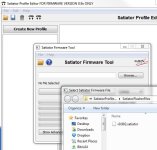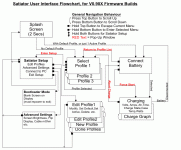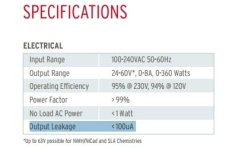r3volved
100 kW
I wouldn't think so since it's now up to v3 and available for quite some time...
7circle said:justin_le said:This would mean you'd just need to put a resistor on the XLR charge port of any battery pack you have and map it to the correct profile on the satiator, without any additional smart logic or communication, and have all your batteries load their profile automatically. It'd work fine for individual or private fleet applications, but not really a widerspread universal solution. For that I think we're going to wait and see what happens with the energybus standard and most likely adopt that route, with a charge calbe that has a LIN->CAN converter built in.
http://www.energybus.org/
...
Further ideas on the cable selected profile.
Using both a resistor and a capacitor in parallel would add an extra dimension to the detection.
A cap of say 1uF would cause a ramp up and the delay timing be detected.
Then a further dimension be added when discharging this cap by having a diode and a second resistor.
So R1 gives Rate
C gives capacity
And diode( option of resistor) gives auto ON/ENABLE instead of Manual prompt to say yes.
All with just ADC input of microcontroller with output/input select.
>SNIP<
Having 3 factors make the chance of some odd battery or other device being connected and charged wrongly.
justin_le said:It's been a few weeks since I've posted a meaningful update here and it's because we're trying to cram and test a lot of target features for the V1.0 release,


The cable resistance is now user settable as well. So if you replace or lengthen/shorten the charge cable to your battery, then you can have the satiator compensate accordingly via a custom cable resistance so that as much as possible the displayed output voltage is the voltage on the terminals of your battery pack rather than the voltage on the charger output.
This then opens up the possibility for us to experiment with having the Satiator bulk charge to a target open circuit pack voltage by including the battery's internal resistance into the cable resistance term. So if your battery is 200mOhm, and the cable resistance is 87 mohm, then if you set this to 287 mOhm it should in principle bulk charge the pack right to your desired target voltage with no extended trickle down period at the end, as we discussed earlier in this thread. Most BMS circuits wouldn't allow that behavior to full 4.2V/cell charge voltage since it would trip the BMS, but they should work fine if it is like an 80% or 90% charge where the combination of the open circuit cell voltage plus the IR drop is still less than the cell upper voltage cutoff.
Simple818 said:God I wish I could get my hands on one of these now. This thing is beyond badass. It like the perfect battery charger
justin_le said:We then increased the cable resistance to 0.5 ohms, which in theory should have been a fair bit more than the batteries internal resistance. In that graph, you can see an even steeper rolloff of current in the constant voltage mode, but then at 62 minutes it cuts out entirely, presumably from a BMS tripping event, and then cycles on and off a few times.

zlagger said:Can this charger be left connected to the battery when not charging, or will it drain the battery?

johnrobholmes said:I would suggest listing "parasitic drain" or "standby current" and use 0.0001 amp @ 63v or 0.00006 amp @ 36v. I know good and well how to figure those things out but didn't want to make the assumption that your output leakage was measured with no AC power on the charger. Make it easy, cause even the technically inclined folk will overthink it and still ask questions :lol:

dogman dan said:Badass Justin. Well done to get it up and selling on the site. I can only imagine how much effort that took.


Bootloader Version is...1 6.
Erasing 24 pages from c00 to 9c00
All flash above bldr erased!
file opened
buffers clearedFailed to open file!
hex file loadedhex file read failure!cal3thousand said:I haven't been able to flash any of the .satiator files.
The latest file that I have been successfully able flash was the Satiator_V0.815.hex file.
The flasher tool doesn't see any files other than .hex and these new files are saved as .satiator.
BVH said:Looking forward to setting up two profiles for my two identical 51.2 nominal, 12 Ah LiFeP04 packs. 1st is a termination of 3.5 Volts per cell and 2nd is 3.65 Volts per cell. I'll execute the 1st profile charge and when finished, will execute the 2nd to see how much additional capacity goes in. I want an idea of how much less capacity I'll get when regularly charging to 3.5 VPC to extend life/charging cycles.
I know capacity "in" is not necessarily indicative of capacity "out" be it will be close enough for my interests.
